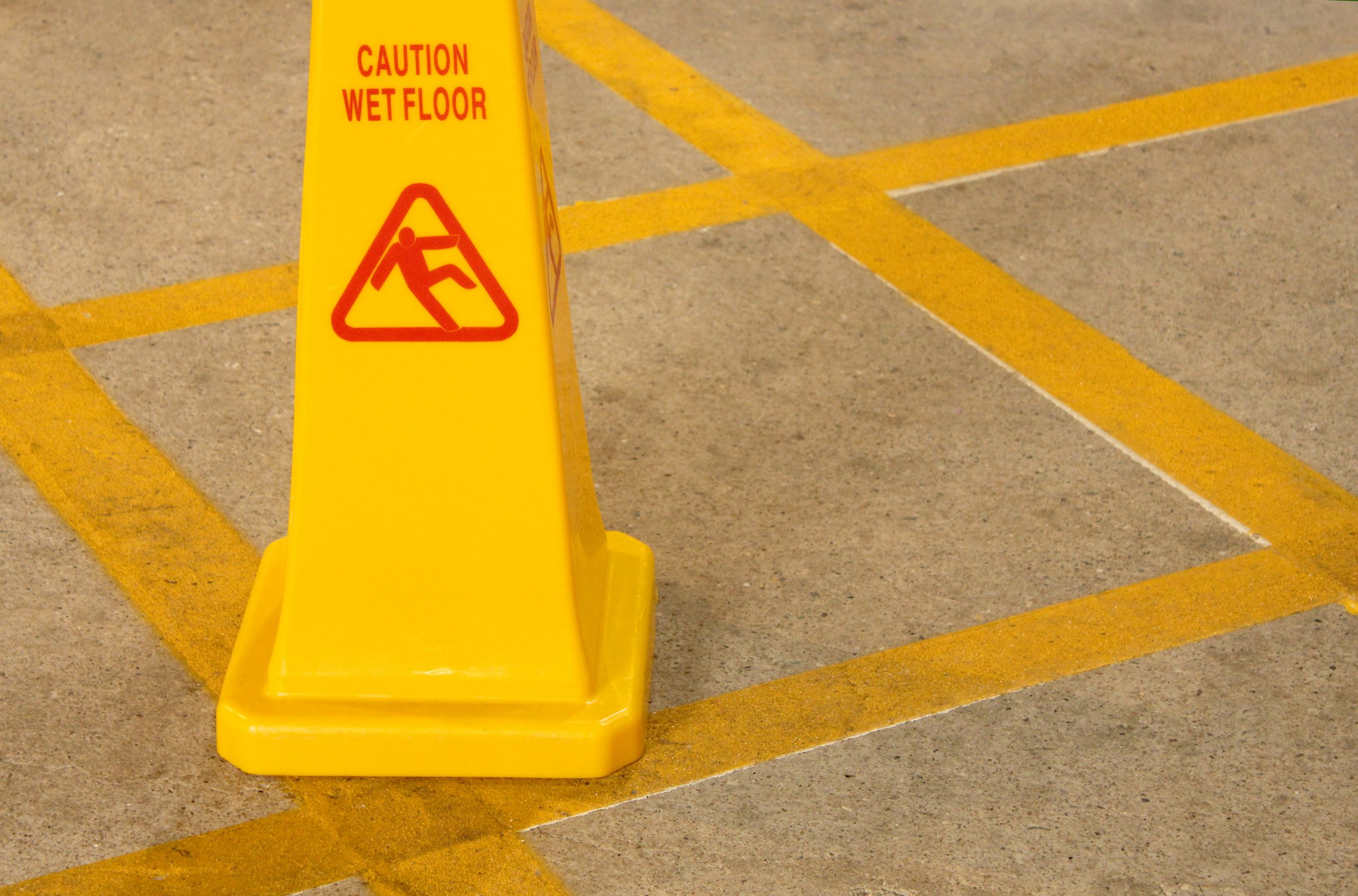Home | Knowledge Hub | News & Insights |
How to Avoid Slips and Trips in the Workplace
Andrea Stevenson | 11th January 2023 | 5 mins
Much like in our everyday lives, accidents like slips and trips are commonplace but there are measures that can be put in place to help avoid them. Cultivating a safe workplace for employees is an important part of improving morale, retaining staff, boosting profits, maintaining the overall happiness of employees and ultimately keeping people from harm.
Slip, trip and fall incidents are one of the top three contributors to non-fatal injuries within the workplace. The HSE reported that an estimated 33% of non-fatal injuries to employees in the year 2020/21, were the result of slips, trips and falls. They also reported that 95% of major slips result in broken bones and can also cause falls from height. Most of these incidents could have been prevented by adopting stronger health and safety procedures.
The responsibility of reducing accidents falls to both employers and employees. While it is an employer’s duty to, as far as is reasonably practicable, keep employees safe at work, the employees have an equal responsibility to follow the rules and regulations that are in place.
Potential Causes of Slips and Trips
Much like in our everyday lives, accidents like slips, trips and falls are commonplace but there are measures that can be put in place to help avoid them. Often slips and trips can be avoided if hazards are given sufficient time and attention, to be dealt with properly.
Accidents may arise from a range of things, such as;
- Housekeeping and contamination
- Peoples’ attitudes and human error
- Surface and flooring types and conditions
- Surrounding environments
- Workplace appropriate footwear
All of the above are affected by different factors, which contributes to how bad the accident could be if the hazard is not dealt with.
Housekeeping and Contamination
When surfaces are cleaned, they should be given sufficient time to dry and wet floor signage should be placed on the surface whilst it is drying, to alert people of the risk.
A contamination in this instance is when a substance comes into contact with a surface and compromises the stability of that surface. This could be liquids or material in the form of leaks, cleaning agents not being sufficiently dried off, a container overflowing, dust, excess water or mud from dirty footwear. If these things are not cleared, it leaves potential for accident.
Attitudes and Errors
Attitudes towards avoiding accidents is important when reducing risk. Contaminations should be cleared up, correct footwear should be warm consistently and care should be taken when walking, to avoid obstructions. Employees should not work with machinery if they feel very fatigued, as loosing concentration can be disastrous. Procedures are made for a reason: to be followed. Employees should adhere to procedures consistently.
Surfaces and Flooring
Flooring material should be chosen carefully and in line with the tasks that will be carried out on them. Durability should be a main consideration when deciding on surfacing type. They should be maintained effectively and any additions such as slip mats should be added where necessary.
How badly affected a surface or flooring becomes from a contamination, can also depend on the flooring type. Smooth surfaces may generate a higher risk of hazard when contaminated, in comparison to a rough one, due to the grip it provides. Extra care should be taken when dealing with contaminations on smoother surfaces.
The condition of flooring, i.e., if there are any uneven or damaged parts, contributes to how hazardous a surface is. If a surface is not fully intact, repairs should be made hastily. These might be potholes in car parks and walkways, for example, or a loose piece of carpet or floor tiling. Essentially, any walkway areas should be level-surfaced.
Environments
Environmental factors can include things like light levels, weather and noise, all of which can contribute to hazards. For example, condensation on a window has potential to drip onto a floor or a machine and cause those to become slippery or affect it’s working order, creating potential for a slip or other accident. It is important to monitor such factors and ensure connecting hazards are dealt with effectively. Lack or excess or light can affect peoples’ vision and therefore their perception, leaving potential for accidents.
Footwear
Suitable footwear should be chosen based on the risk posed by the tasks an employee completes. Steel-toe capped safety boots are popular in construction settings due to the foot protection they offer in the case of objects falling or puncturing the foot. For work involving exposure to chemicals, slip-proof or chemical-resistant soles may be more appropriate. Within the electrical field, completely waterproof or insulated shoes are more fitting.
Preventing Accidents
Prevention is the best cure when it comes to dealing with risks. A workplace should be vigilant when it comes to hazards. Spotting and dealing with hazards is the best way to avoid accidents. Different prevention methods can apply depending on the work being carried out and the environment surrounding it. It is best to have a working environment assessed professionally, as there may be hazards that go unnoticed.
Employers can ensure best practice by defining safe systems of work. Creating a safe system of work is particularly important for high-risk fields such as construction, manufacturing and warehousing.
They are created by carrying out research on the people, equipment, materials and hazards involved, conducting risk assessments and then formulating a work process which minimises the risks.
The safe system of work should be shared with all employees, so that they can follow the processes. Processes within workplaces tend to evolve with time and so do safe systems of work, which should be reviewed regularly to determine their efficiency and effectiveness and updated as necessary, as well as when new hazards arise.
Employers should;
- Ensure employees are aware of the hazards
- Display visual warnings about hazards in the appropriate places
- Ensure machinery is used properly and maintained well
- Have good housekeeping procedures in place
- Ensure employees wear suitable clothing and footwear for the environment they work in
- Know and abide by the appropriate working temperatures for the line of work
- Have safe systems of work outlined and communicated to employees
Employees should;
- Adhere to the safe systems of work that are in place
- Take note of safety signage and act accordingly
- Ensure they wear the correct clothing and footwear for their role and environment
- Help to alert management if hazards develop
- Ensure proper use of machinery
Creating Awareness and Enabling Action
Employers are responsible for ensuring they provide a safe environment in which employees can carry out their work. It is the employee’s responsibility to follow procedure and take the necessary precautions.
Safety signage should be placed where they are plainly visible and are relevant to the hazards. Having visual reminders and warnings can help to encourage employees to comply with procedure.
Awareness can also be increased by having regular health and safety meetings which address the hazards and explain how to deal with them, to prevent accidents from occurring. This gives employees ample opportunity to suggest ways of dealing with hazards that can help solve issues and simultaneously encourage care for safety and morale.
The majority of errors are made in response to unplanned or unintended actions. In other words, a person may be unaware of how to safely complete a task. They must be educated properly on the safe way of completing that task and thereafter, non-compliance must be challenged, in order to maintain adherence to procedures.
Winter Specific Safety Procedures
Risks pose a problem for workplaces all year-round, but the winter months present a host of unique issues to deal with. Adverse weather conditions can affect an employee’s ability to work, the time it can take for an employee to carry out a task and can change how safe a task is to complete.
Signage such as ‘caution ice’ and ‘beware of ice and snow’ help to draw attention to the unstable conditions of walkways, car parks and other areas accessed by employees. Drawing such attention encourages individuals to exercise extra caution when walking on those surfaces.
Gritting surfaces before and after snow falls and ice forms, can help to prevent slips a great deal. It is generally a good idea to perform gritting after heavy rainfall and before the ground temperature approaches freezing, for maximum effectiveness.
Fallen leaves in Autumn and throughout winter tend to be widespread and cover surfaces which, when they become wet or icy, can present a serious safety risk. Safety signage such as ‘risk of falling’ is advised for this issue.
For more on managing hazards in the workplace, see our Health and Safety page, or contact us on 0344 288 9000 to speak to an expert.
Other Insights
Share
Get in touch
hello@theomgroup.co.uk
0344 288 9000
Any questions?
We’re here to help. Ask us a question and one of our experts will provide you with a detailed reply.




